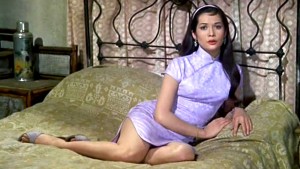
This photo is a screenshot from the 1960’s American film, “The World of Suzie Wong.” This film tells the story of an American artist, Robert, and a Chinese prostitute, Suzie, who fall in love. The photo above features Suzie in Robert’s bed, posing for him as he paints her. This movie envelopes and further perpetuates the stereotype of a hyper-sexualized Chinese woman who needs to be saved by a Western man. In the 1960’s the qipao shifted from a Chinese symbol of national pride into an article of clothing that enveloped Western stereotypes of Chinese sexuality and femininity.
In this photo Suzie is dressed and positioned to invite a Western male gaze. She is being filmed from the perspective of a Western male who is painting her. This invites the audience, who is primarily a Western audience, to also observe her and prescribe our own interpretation of who she is onto her. Her body is turned to the audience and she is positioned in a way that exposes her womanly shape, furthering the invitation to stare, fantasize and orientalize Suzie. This photo exemplifies how in the 1960’s the qiapo began to be viewed in a Western world. This photo invites Westerners to gaze upon Suzie as an Oriental woman, and it also invites Westerners to prescribe sexual stereotypes unto the Oriental women. good point which needs explanation of how qipao generates invitation of gaze?
Throughout this film, Suzie and all Chinese woman are hyper-sexualized and exist only in relation to a Western man’s sexual desires. This photo demonstrates the sexualization of the qipao in Western culture. This qipao is extremely form-fitting with a high slit that exposes most of Suzie’s leg. This sexualizes Suzie by placing the importance of her worth on her body. She is also positioned in a sexual manner on a bed, furthering the pairing of sexuality with the qipao. Her leg is completely exposed and both her breasts and and hips are facing the camera. This photo sexualizes both Chinese women and the qipao. refine writing
This film also focuses on the femininity of Asian woman. Although Suzie is portrayed as hyper-sexualized, she is also feminized. Suzie is portrayed as weak and as needing the intervention of an American men and this can be seen in the photo. The qipao is lavender colored, a color that represents subdued femininity. Although she is positioned in a sexual manner on a bed, she also covers some of herself with her arm. This shows that although she is a sexual being, there is also an aspect of innocence here. Her face appears worried or scared invoking feelings of her helplessness. As an audience we are meant to pity her, and therefore want her to be saved from this life absent of Western morals.
focus on the color
This photo symbolizes the Western view of a sexualized and feminized Chinese woman and it connects these stereotypes with the qipao. In the 1960’s the qipao began to become popular in Western culture. However, in China the qipao declined in popularity in 1960’s. This demonstrates how Western perspective can take aspects of other cultures and use them to develop false notions of these cultures.
focus on the relation between female body and qipao in terms of design, color, and significance
